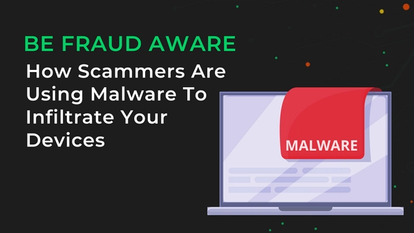Be Fraud Aware: How Scammers Are Using Malware To Infiltrate Your Devices

As many of us are continuing to work from home and completing more activities online, malware is something we should all be aware of. It's a growing problem that affects both individuals and businesses which involves infecting your device without your knowledge or permission - often to steal sensitive information or money from unsuspecting victims.
Criminals are getting smarter and they’re banking on you being unaware of their tactics, which is why we’re here to help you strengthen your fraud defences with our latest blog on how malware fraud works.
What is Malware?
Malware is a type of malicious software that’s often installed on a user’s device without their knowledge. It can come in the form of a virus, Trojan, worm, or other malicious code. Once it's on your device, it can do all sorts of things such as stealing sensitive information, spying on your activity, and damaging your device or making it unstable.
What is Malware Fraud?
Malware can be used to steal personal information or financial data from your digital devices. This includes stealing credit card information, bank account details, passwords, and other sensitive information. Once a criminal has access to this information, it’s fairly easy for them to commit crimes such as Identity Theft, Credit Card Fraud or take up loans in your name.
How does malware get on my device?
Malware can spread in a number of ways. Sometimes, it's bundled with other legitimate software that you download from the internet. It can also spread through phishing emails or text messages with links to the malware or malicious attachments, social media posts, messages with links that take you to fake websites to install the malware, apps or even USB drives.
Some recent malware warnings include the Student Loans Company urging students to be aware of malware links in phishing scams as the new academic year starts and apps available from Play Store containing malware.
How do I know if my device has malware?
Red flags that may mean your device has been infected with malware:
1. Your device is acting strangely such as closing and opening programs, shutting down unexpectedly or is slower than usual.
2. New programs are appearing without you having installed them, which you’re unable to uninstall.
3. Your browser’s home page or search engine has changed without your permission.
4. You receive warnings or pop up ads even when you're not using your browser.
5. You're being redirected to strange websites.
6. Your accounts have unusual activity, or your bank account has unrecognised transactions.
7. Your information and identity has been stolen.
8. You’re unable to access your device and you’ve received a ransom demand for your files.
How do I remove malware?
There is no one-size-fits-all answer on how to remove malware from your device, as this depends on the type of malware that is present and the infection itself. However, some general tips that may be helpful in removing malware include using a reputable anti-malware program to scan and clean your computer, running an antivirus scanner, resetting your device or restoring it to an earlier backed up version.
Malwarebytes is an industry-recognised anti-malware software that offers a free version, as well as paid versions if you’re looking for specific malware protection.
If you’re looking for a full antivirus program and scanner, we suggest you have a look at Bitdefender, Eset, Microsoft Defender, Norton, Panda, Sophos and McAfee. Most offer free versions, in addition to paid versions if you’re looking to boost your device security even more.
How do I protect myself from Malware?
Protecting yourself against malware is relatively simple - what's most important is remembering to stay alert and knowing what to look out for. Be on the lookout for these warning signs of a scam and protect yourself from malware viruses by following these simple tips:
1. Protect your devices with antivirus and anti-malware softwares, in addition to a firewall and any security tools your device comes with.
2. Enable two factor authentication on all your accounts - if you’re able to, choose an authentication app, such as Microsofts Authenticator, over SMS or email verification.
3. Make sure your passwords are strong and that you use a different one for each account - use a Password Manager to create and save your passwords.
4. Use cloud backup to make sure your files are safe if anything should happen to your device.
5. Only download and install programs from trusted sources. If you’re unsure about the source, research the source online before taking any further actions.
6. Keep up to date with your account activity - investigate and report any unknown activity.
7. Don't click links or open attachments in unsolicited email messages.
8. Be wary of pop-up ads. They often contain malware.
Although malware may seem daunting, by keeping in mind and following the simple steps above, you can help keep yourself, and your data, secure. Stay alert when navigating the web, and think twice before you click.
Want to strengthen your fraud defence even more? Learn How to Spot Phishing, Smishing and Vishing Attempts Before They Happen.





